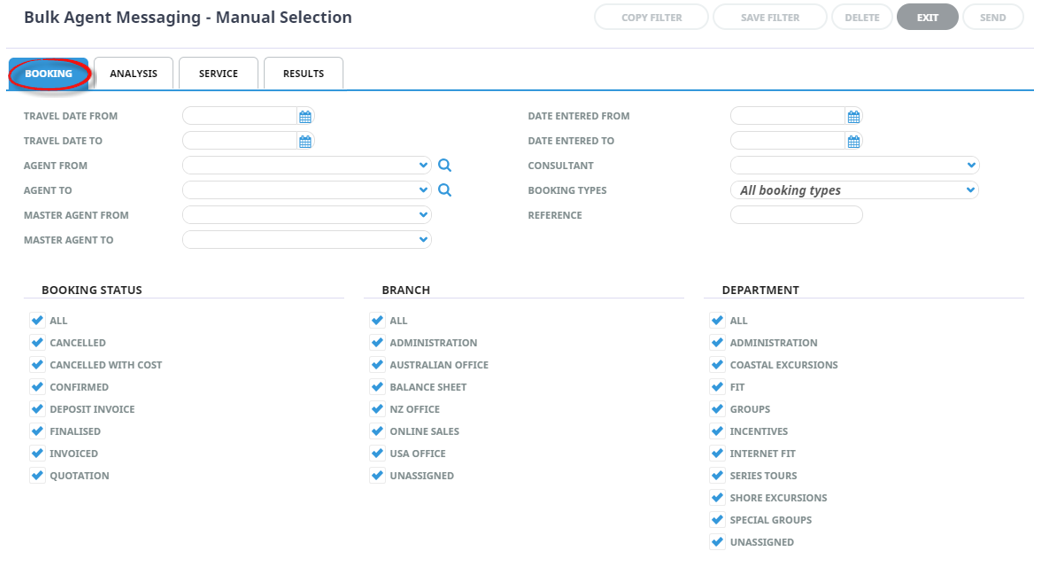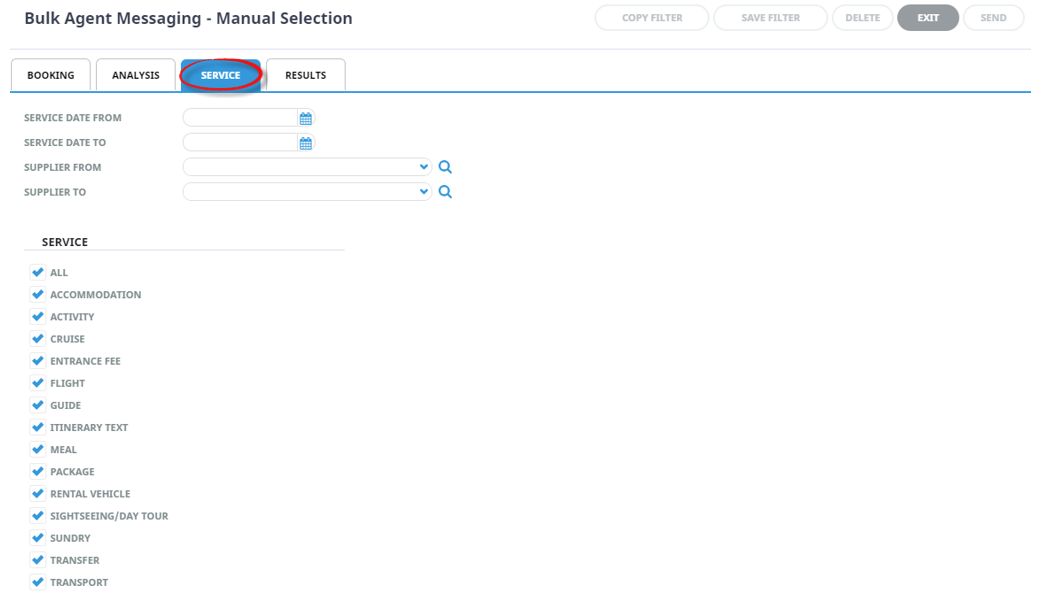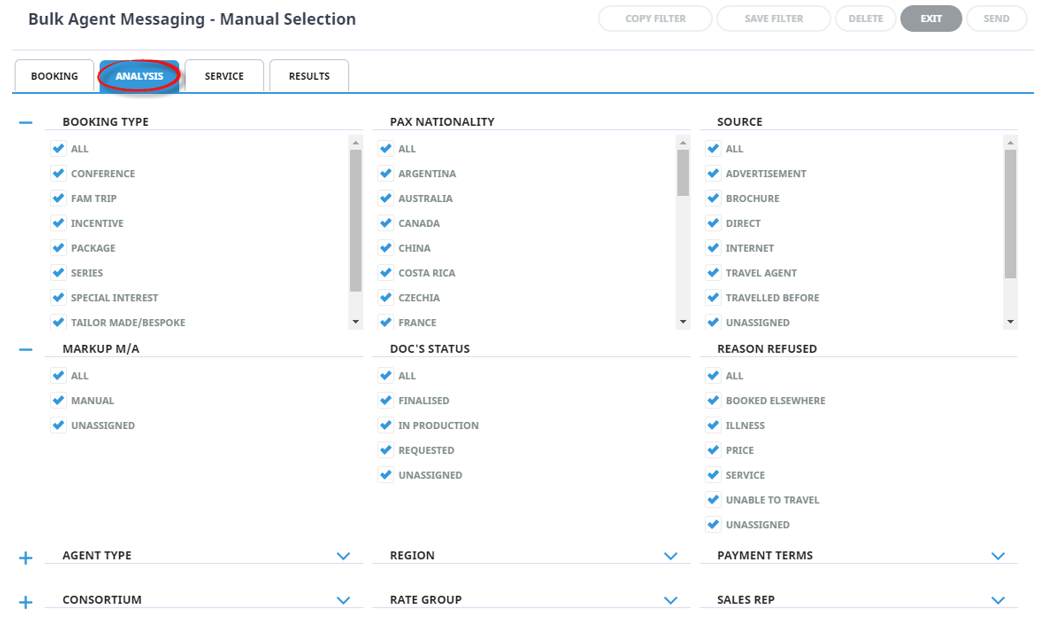Bulk Messaging allows messages to be sent in bulk to Agents. The messages selected and sent can cover multiple bookings. Concurrently, the status of the services that have had messages sent can be updated.
NOTE: Bulk Messaging will not suit all companies. This function is typically used where agent messaging is consolidated (either by user or company) and output at specific times or at end of day.
The selection criteria of frequently sent messages can be saved and recalled. If saved, a list will display when the Agent Messaging menu has been selected. Filters can be copied and saved from within the Bulk Agent Messaging screen.
Create Manual Agent Messaging Filters and Send Messages
-
From the Home menu, select
 Home > Operations > Bulk Documentation > Agent Messaging.
Home > Operations > Bulk Documentation > Agent Messaging.
-
Click
 Manual.
Manual.

-
On the blank
 Bulk Agent Messaging - Manual Selection screen, the Bookings Tab will open, select the required filters from the field selections available within the Booking Tab and the Analysis Tab. View Agent Filter Selections to learn more about all field selections available, or view the individual tab filters:
Booking, Analysis, Service or Results.
Bulk Agent Messaging - Manual Selection screen, the Bookings Tab will open, select the required filters from the field selections available within the Booking Tab and the Analysis Tab. View Agent Filter Selections to learn more about all field selections available, or view the individual tab filters:
Booking, Analysis, Service or Results.
Booking Tab

Services Tab

Analysis Tab

- Check the completed screens.
-
Click on the
 Results Tab. Select the services using the Selected check box next to each service, or the Select All button.
Results Tab. Select the services using the Selected check box next to each service, or the Select All button.

-
To send the messages, click
 Send.
Send.

-
Click
 Exit to discard any changes.
Exit to discard any changes.

About Bulk Agent Messaging Fields
Filter selection combinations are dependent on user's company's requirements. Selection of any filter combinations will return results in the Results Tab.
There are 4 Tabs that include field filter selections:
- Booking Tab
- Analysis Tab
- Service Tab
- Results Tab
Booking Tab
Travel Date From and To - Used to select services with a specific, or range of, travel dates of the bookings to be selected.
Agent From and To - Used to select services with a specific, or range of, agent(s) codes in the booking header matching the selection.
Master Agent From and To - Used to select services with a specific, (or range of) Master Agent code(s) in the booking header matching the selection.
Date Entered From and To - The booking entered date(s) of the bookings to be selected.
Consultant - The consultant code attached to the bookings whose messages are to be output.
Booking Types - Drop-down selection for the type of bookings that messages are to be output from selection includes:
- All booking types - bookings from either FIT bookings or Group bookings will be selected
- FIT's - those bookings that are FIT bookings will be selected
- Groups - those bookings that are Group bookings will be selected
Reference - The reference attached to the booking that message is to be output from. This field will only accept the actual reference number if the Branch/Department components of the booking reference are selected from the Booking Branch and Booking Department multi select boxes.
Booking Status - By default, all booking statuses are checked and bookings that have this status will be selected. Un-check statuses that are not required.
Branch - By default, all branches are checked and bookings that have those branches will be selected.
Department - By default all departments are checked, bookings that have those branches will be selected.
Service Tab
Service Date From and To - The service date(s) of the services to be selected.
Supplier From and To - Used to select services with a specific, or range of, supplier code(s) matching the selection.
Service - Used to select services with a specific, (or range of) service code(s) matching the selection.
Analysis Tab
Booking Analysis - The top two rows of this tab are the 6 Booking Analysis codes. These are booking level selections.
Agent Analysis - The bottom two rows of this tab are the 6 Agent Analysis codes. These are Agent Analysis codes attached to the booking.
Analysis fields can be expanded or minimised by using the + or - function.
NOTE: The label descriptions and analysis selections used within this user manual will vary and will display what has been setup in each user's company's system.
Results Tab
Selected - The cell to the right of this heading will provide you with the number of bookings that have been selected. (This screen capture is showing that 0 services have been selected).
Found - The system will provide you with the number of bookings found matching the filter criteria.
Selected check boxes - Bookings can be individually selected.
Select All and Unselect All - These buttons will allow you to select all services found, or un-select all bookings selected.
Column Headings - Users can customise their column headings by clicking on the column header, or amend the order of results by clicking on the column heading.



